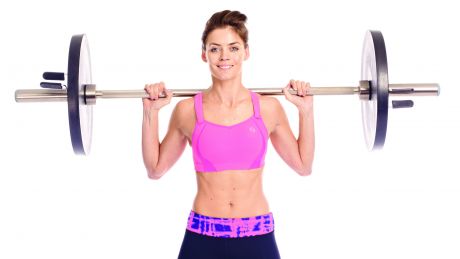The Women’s Fitness Guide To Weight Training
Weight training is the perfect way to boost your metabolism and torch fat, so it’s no wonder strong is the new slim

Thanks to the success of female athletes like Jessica Ennis and Victoria Pendleton taking the Olympic Games by storm back at the London Games in 2012, we're seeing a huge rise in women taking to the weights room in order to sculpt a strong and lean physique. If you're new to lifting weights, though, we're here to help, and we've enlisted the expertise of powerlifter Evelyn Stevenson, too.
“Powerlifting is great for women as it encourages them to weight train correctly, using the three compound lifts to build overall strength,” says Evelyn, who works as a personal trainer when she’s not competing. “It allows us to gain tone yet still keep a feminine appearance by reducing body fat and increasing muscle mass, which is a good thing – a pound of muscle alone burns nine calories a day while fat only burns two.”
The great thing about powerlifting is that the moves target every muscle group, including the core. There are no specific abdominal exercises, but each move switches on your core and uses your abs to accompany the major muscle groups, teaching them to work in conjunction with the rest of the body. Because this is how you use your body in everyday life, it’s a far more useful way to train your abs than isolating your mid-section.
Training all your muscle groups helps to rev up your fat burn, not just while you work out but for hours later, too, thanks to its effect on your metabolism. “As well as getting you in shape, powerlifting increases skeletal strength and helps to reduce the risk of osteoporosis,” adds Evelyn.
Don’t fight the power
A nice side effect to building your muscles? Supreme confidence. “As a woman, I find powerlifting so empowering,” Evelyn says. “Being strong makes everyday life easier, too. It also makes the weights room seem a little less intimidating! I feel confident knowing I can train with a structure and understanding of my goals – something that powerlifting taught me.”
When you notice yourself getting stronger, you might also start to care less about the number on the scales, and more about the number on the weights. Measuring your progress this way can really feel like a huge achievement. “You don’t have to train solely for your one rep max, but you can use powerlifting to structure your gym workout and inspire a long-term goal of increasing strength,” says Evelyn.
How to do it
Olympic barbells used for powerlifting in a gym are usually 20kg, but you can often find adjustable bars that weigh much less if these are too heavy for you. Gradually increase the weight you lift until you can manage the barbell. Make one of the powerlifts – that’s either the squat, bench press or deadlift – your main move in each workout, using as heavy a weight as you can while maintaining good form. Then you can perform the remaining moves with slightly less resistance to make up the rest of your workout. Three workouts a week will target your whole body, burning fat and strengthening both your muscles and bones.
Get the Coach Newsletter
Sign up for workout ideas, training advice, reviews of the latest gear and more.
Your Powerlifting Workout
Try these workouts by Evelyn Stevenson to kick off your new body. Separate your powerlifting workouts into three weekly sessions consisting of five different moves, including your main powerlifting move. These should challenge you, but not prove impossible to complete. Finish performing every set of each move before moving onto another exercise. Take 60 to 90 seconds’ rest between each set.
Day 1
Main lift: Squat (as heavy as possible with good form)
Plus, the following moves at around 70% of the maximum weight you’d usually manage:
- Bench press
- Straight-leg deadlift
- Barbell row
- Step-up
Day 2
Main lift: Bench press (as heavy as possible with good form)
Plus, the following moves at around 70% of the maximum weight you’d usually manage:
- Squat
- Overhead press
- Straight-leg deadlift
- Deadlift
Day 3
Main lift: Deadlift (as heavy as possible with good form)
Plus, the following moves at around 70% of the maximum weight you’d usually manage:
This article first appeared in Women’s Fitness
Amanda Khouv formerly worked for Women’s Fitness magazine, which briefly shared a website with Coach. Khouv began working for Women’s Fitness as editorial assistant in 2012, working her way up the masthead, finishing as deputy editor between 2015 and 2018.
